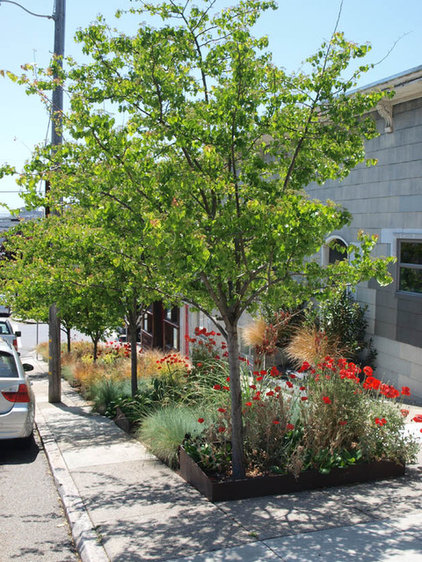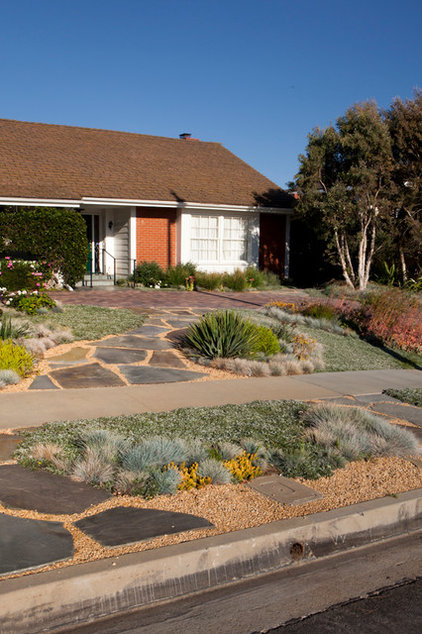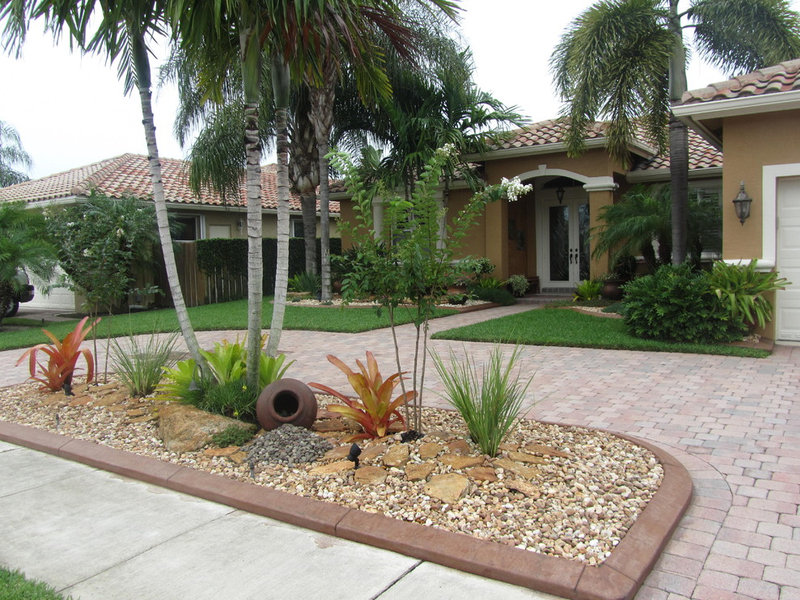 Arterra LLP Landscape Architects
Transforming a strip is not necessarily difficult, but it does have issues. Because the patch is narrow, water can easily run off before it soaks into the soil, and maintaining an area farther out from your home is probably not the most fun garden task. It is also typically battered by the Gainesville, Florida sun for 8-10 hours a day In addition, the soil can easily become compacted from foot traffic. But don't be discouraged — informed is forearmed!
Arterra LLP Landscape Architects
Transforming a strip is not necessarily difficult, but it does have issues. Because the patch is narrow, water can easily run off before it soaks into the soil, and maintaining an area farther out from your home is probably not the most fun garden task. It is also typically battered by the Gainesville, Florida sun for 8-10 hours a day In addition, the soil can easily become compacted from foot traffic. But don't be discouraged — informed is forearmed!Before you plant:
• Check with your neighborhood association, homeowner's association or Gainesville's code enforcement to learn what is allowed in your area.
• Use a contractor-quality weed barrier fabric under any rocks to keep weeds to a minimum. You will still have weeds in this area, but anything you can do to decrease the rate is recommended. This will also stop the rocks from sinking into the soil as well.
• Plants in this area need to be tough as nails.
• Remember that this space is, in many areas, a public space and not your private property. If your city needs to widen your street or do work in that area, you will not have much say in the outcome. Remove any materials or plants you want to keep before they are removed for you.
• Consider some edging material (steel, concrete, rock) to keep your mulch or rock in place, but keep it low to avoid tripping hazards.
 Gregory Davis & Associates
Design Ideas for the Parking Strip
Gregory Davis & Associates
Design Ideas for the Parking StripTry one of these options for your own strip to turn it from ugly to heavenly.
Create landing pads. Your visitors will typically pull up to the curb when they are stopping by, so if you thickly plant this area, they will be forced to step on your plants just to exit their vehicle. Give them a place to step onto instead. Use oversize flagstone pieces to create landing pads or pour concrete insets into several areas along your strip.
 Jocelyn H. Chilvers
Add evergreens. There's no need to get all fancy with your plant material, particularly if the rest of your front yard has plenty of appeal. It may make sense to choose some low-growing evergreen plants, like junipers or other dwarf shrubs, to create textural interest year-round. Read the plant tag carefully to avoid accidentally purchasing shrubs that lose their leaves over the winter.
Jocelyn H. Chilvers
Add evergreens. There's no need to get all fancy with your plant material, particularly if the rest of your front yard has plenty of appeal. It may make sense to choose some low-growing evergreen plants, like junipers or other dwarf shrubs, to create textural interest year-round. Read the plant tag carefully to avoid accidentally purchasing shrubs that lose their leaves over the winter.
 Eric Aust Architect
Keep it neat with grass. Turf grass is a traditional material to use in these strips, and while it is a valid choice, it is not the only option. If you do decide to go with turf, be sure to keep it neat and edged, weed it regularly and don't allow it to become an eyesore.
Eric Aust Architect
Keep it neat with grass. Turf grass is a traditional material to use in these strips, and while it is a valid choice, it is not the only option. If you do decide to go with turf, be sure to keep it neat and edged, weed it regularly and don't allow it to become an eyesore. In some cases a well-maintained strip of turf can be the perfect foil to other front-yard landscaping, like the courtyard wall and pots in this example. Choose turf grass in this strip if it makes sense to your overall aesthetic, not because you lacked creativity when making the decision.
Of course, many people are interested in low-maintenance alternatives to traditional lawns.Get some ideas for going lawnless here.
 Lazar Landscape Design and Construction
Start simple. Small trees give a narrow space vertical appeal, but be sure to read the tree description to make the best choice. You don't want the tree at its mature height to hit people getting out of their cars, so look for trees that are in the 10- to 15-foot-tall range. Bonuses would be textural bark, fall leaf color or springtime blooms.
Lazar Landscape Design and Construction
Start simple. Small trees give a narrow space vertical appeal, but be sure to read the tree description to make the best choice. You don't want the tree at its mature height to hit people getting out of their cars, so look for trees that are in the 10- to 15-foot-tall range. Bonuses would be textural bark, fall leaf color or springtime blooms.Browse tree profiles in the Houzz Gardening section
 Falling Waters Landscape
Add some rock. Small river rock or cobblestones are an attractive complement to simple plantings, and they can effectively take the place of organic mulch. While this works especially well in areas with heat and drought, it's a great option for any curbside garden. Be sure to use river rock that is at least 1 inch in diameter (not tiny pea gravel) to avoid its spilling onto the sidewalk or washing away during a heavy rain.
Falling Waters Landscape
Add some rock. Small river rock or cobblestones are an attractive complement to simple plantings, and they can effectively take the place of organic mulch. While this works especially well in areas with heat and drought, it's a great option for any curbside garden. Be sure to use river rock that is at least 1 inch in diameter (not tiny pea gravel) to avoid its spilling onto the sidewalk or washing away during a heavy rain.
 KL Designs Residential Landscape Planning
Get colorful. There's no reason to avoid low-growing flowering perennials in this more public space — in fact, they create a very friendly and cheerful welcome.
KL Designs Residential Landscape Planning
Get colorful. There's no reason to avoid low-growing flowering perennials in this more public space — in fact, they create a very friendly and cheerful welcome. Choose plants that have a low profile or even a slightly mounding or cascading habit, and be sure these plants blend in with the other plants in your front-yard garden. Avoid plants that have long tendrils or vining habits unless you plan to keep them neatly edged.
 Create islands. If you have the opportunity while you are building a house or remodeling your front yard, consider creating a type of island bed rather than the more expected long rectangle. You will have more opportunities for planting and design if your bed is a different shape and larger than the traditional curb strip.
Create islands. If you have the opportunity while you are building a house or remodeling your front yard, consider creating a type of island bed rather than the more expected long rectangle. You will have more opportunities for planting and design if your bed is a different shape and larger than the traditional curb strip.
 Diamondscape, Inc.
Add soft plantings. Those pulling up to your curb won't want their cars scratched by overgrown spiny plants, so be sure to use plants that have soft foliage, like ornamental grasses. Look for short to medium-height grasses (18 inches or shorter), like blue fescue or another variety that's appropriate for your area. Avoid any plant with thorns or spines, like yuccas, agaves and roses.
Diamondscape, Inc.
Add soft plantings. Those pulling up to your curb won't want their cars scratched by overgrown spiny plants, so be sure to use plants that have soft foliage, like ornamental grasses. Look for short to medium-height grasses (18 inches or shorter), like blue fescue or another variety that's appropriate for your area. Avoid any plant with thorns or spines, like yuccas, agaves and roses.
